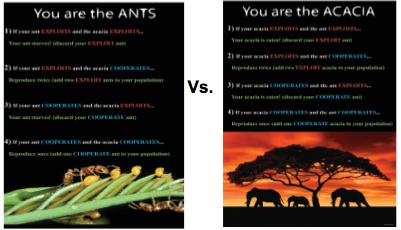All species interact with other species in their community. Some types of interactions are antagonistic, where one species benefits at the expense of another- such as predators and prey, or parasites and their hosts. However, interactions between species may also be mutualistic, where both species benefit from interactions with one another. Examples of mutualisms abound in nature, such as pollination, cleaner fish, and gut bacteria.
Interacting species are constantly co-evolving. Predators may become faster to overcome their prey, while the prey get better at dodging attacks. Likewise, in cooperative interactions, each species is under selection to obtain the most benefit from the interaction at the lowest cost. Since cheating may have immediate benefits to an organism, it is difficult to understand how mutualisms evolve and remain stable through time.
This lesson explores the circumstances that favor the evolution of cooperation, and why two species might cooperate. By using a card game simulation, students will see how cooperation is maintained, or lost, between ants and acacia trees depending on the environment they are living in.
At the conclusion of the lesson, students will be able to:
- Give examples of cooperatively co-evolved species
- Describe why species might cooperate in the wild
- Perform a simple simulation of species interaction
- Graph the outcome of a simulation
Resources:
- Lesson plan
- Powerpoint (pdf, reduced file size)
- Worksheet
- Sets of playing cards (4)
- Supporting literature
- Palmer TM et al. 2008. Breakdown of an ant-plant mutualism follows the loss of large herbivores from an African savanna. Science 319:192-195.
- Stanton ML & Palmer TM. 2011. The high cost of mutualism: effects of four species of East African ant symbionts on their myrmecophyte host tree. Ecology 92:1073-1082.
Lesson Plan created by GK-12 Fellows Emily Dittmar, Pat Hanly, and Amanda Charbonneau, 2014

